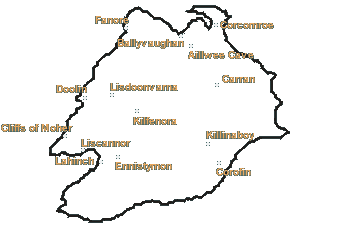
|


Cahermacnaghten
over the top of Corkscrew Hill is the circular stone fort,
which once housed one of Ireland's most famous medieval law schools under the
 care and management of the O'Davorens, a family of hereditary legal scholars and
teachers. Donald O'Davoren is credited as the compiler of both a Breton Law Glossary
and "The prophecy of Conn of the Hundred Battles" concerning the succession of the
kings of Tara and the coming of St. Patrick.
care and management of the O'Davorens, a family of hereditary legal scholars and
teachers. Donald O'Davoren is credited as the compiler of both a Breton Law Glossary
and "The prophecy of Conn of the Hundred Battles" concerning the succession of the
kings of Tara and the coming of St. Patrick.
Poll na Gollum (Poll na gColm - cave of doves), 4 km from the Cahermacnaghten
has nearly 12 km of charted passageways available to the experienced caver.
Cahercloggaun is a much dilapidated O'Loghlen castle built in the 15th century.
Lisdoonvarna
(Líos Dúin Bhearna - fort of the gap)
Is a very popular holiday resort especially during the late spring and early
summer, when the Burren flora is at its best.
Later in the year the countries only active spa wells attract many for their
reputation as health restoratives. The Spa Wells Health Centre offers a sulphur
spring, sauna baths, showers, sun lounge and massage rooms and a recreational
hall. There are other iron amd mangnesia springs sprinkled around the town.
The town park offers leisure facilities including walks, playing fields, tennis
courts and a pitch and putt course.
September is traditionally high season for music and fun at the match-making festival.
Spectacle Bridge west of the town crosses the Aille River as it flows westwards
through a deep narrow gorge to Doolin. The double arch, necessary to support the
bridge at a height 25m above the river, forms a circular opening. Hence the unique
'spectacle' appearance.
Kilfenora
(Cill Fionnúrach - Fionnúir's church)
Until recent times the villages significance lay in  its being the ecclesiastical
capital of the small diocese of Kilfenora, now administered from Galway. its being the ecclesiastical
capital of the small diocese of Kilfenora, now administered from Galway.
Kilfenora Cathedral: now partly roofless, received its cathedral status when
Kilfenora became a diocese in the 12th century. Its first bishop was St.
Fachtna. Only the nave is now in use, having been incorporated in the Protestant
church. The three-light east window of the unroofed chancel (c. 1200) is worth
notice with a tomb effigy occupying the wall on either side.
There are three High Crosses in the churchyard and another to the West of it.
(A fifth now stands in St. Flannan's Cathedral in 1821). The most interesting
is the ornately carved Doorty (0'Dughartaigh - a Tipperary family with hereditary
rights to the bishopric) cross dated from the 12th century, showing three
bishops on one side and a crucifixion on the other.
The village has been developed as a centre for Burren tourism through local enterprise, evolving into a thriving market village that houses
the Burren Display Centre, (Brú na Bóirne). The centre offers an insight
into all aspects of the Burren life: scenery, geology, settlement patterns,
flora and fauna with the aid of scale model of the area interpreted in an
exciting sound and light sequence.
local enterprise, evolving into a thriving market village that houses
the Burren Display Centre, (Brú na Bóirne). The centre offers an insight
into all aspects of the Burren life: scenery, geology, settlement patterns,
flora and fauna with the aid of scale model of the area interpreted in an
exciting sound and light sequence.
The Burren
The unique diversity of the Burren's flora has  constantly attracted much attention
and is at its best about mid-May or a little later. constantly attracted much attention
and is at its best about mid-May or a little later.
Its extraordinary rock formations, spreading over over 500 sq km, have been
refered to by many observers including General Ludlow, who led Cromwellian
forces to Limerick and Clare in 1651 as "a lunar landscape". The Limestone pavements
are a direct result of glaciation and erosion.
The area is rich in megalithic tombs and ring forts steeped in antiquity.
  
|
|
















|

